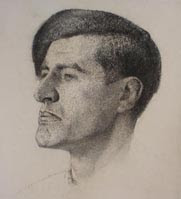With thanks to Ognyan Hristov for finding these artists and their work
and for his help in finding other artists of WW1
1. ′′ The front near the river Vardar ", 1917, watercolor;
Artist: Joseph Denovan Adam Jnr (1881-1935), son of Joseph Denovan Adam (1841-1896).
2. ′′ Hours on post ", 1917, watercolor;
Artist: Joseph Denovan Adam Jnr (1881-1935)
3. ′′ Close to the positions near Lake Doiran ", 1917, watercolor;
Artist: Robert Houston (1891), Scottish. Served in the British army in Macedonia in 1917 Located in Thessaloniki, draws numerous watercolors and drawings from the areas of Thessaloniki, Lake Doiran and Belasitsa Mountain.
4. ′′ Transportation of injured in the village of Small ′′ (Aegean Macedonia), 1916, oil;
Аrtist: Sir Stanley Spencer (1891–1959). 24-year-old Spencer was sent to Macedonia with 68th Field Ambulance. In 1917, 1917 he voluntarily transferred to infantry division of 7th Battalion, the Berkshire Regiment. He fought against German and Bulgarian troops before being disabled by the army after permanent malaria attacks.
5. ′′ Lake Doiran", 1917, watercolor
Artist: Gerard Chowne (1875-1917). Born in India, Chowne studied at the Slade School from 1893 to 1899, as well as in Rome and Paris. He began to exhibit at the New English Art Club in 1903 and became a member two years later, when he also commenced teaching painting at Liverpool University. Chowne fought in Macedonia during the Great War, where he was appointed Captain in the 9th East Lancs Regiment. He was wounded and died in Macedonia from his wounds. During his time in Macedonia, he painted a series of watercolors depicting Thessaloniki, the Macedonian Front and various military scenes.
6. ′′ Down!", 1918, oil (De Havilland 2 single-seater scout, downloads Fokker monoplan in Thessaloniki);
Аrtist: William Thomas Wood (1878 - 1958) – Mentioned in Despatches
During the First World War, William served as an Acting Corporal in the Royal Flying Corps, attached to Salonika Balloon Company where he was a kite-balloon observer. William was appointed Official War Artist in The Balkans in 1918. Because of that, Arthur J. Mann asked William to illustrate his book “The Salonika Front” (A. & C. Black, London, 1920).
The Salonika Campaign.
From 1915 to 1918, British troops were part of a multi-national Allied force fighting against the Bulgarians and their allies in the Balkans. Although disease and the harsh conditions took a heavy toll, they eventually brought the campaign to a successful conclusion.
If you are interested in the Salonika Campaign of the First World War, why not join the Salonika Campaign Society? Formed to promote interest in the Salonika Campaign, which was fought in northern Greece, Serbia and Albania from 1915 to 1918, the aim of the Society is to perpetuate the memory of those of all nations who served, whether they were members of the armed forces, medical services or civilian staff. The Society does not seek to glorify war and is neither politically nor commercially motivated.
Application for membership is welcomed from anyone of like mind.
https://salonikacampaignsociety.org.uk/































